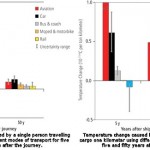
Geneva – Evidence suggests that climate change has led to changes in climate extremes such as heat waves, record high temperatures and, in many regions, heavy precipitation in the past half century, the Intergovernmental Panel on Climate Change (IPCC) said on March 28.
Climate extremes, or even a series of non-extreme events, in combination with social vulnerabilities and exposure to risks can produce climate-related disasters, the IPCC said in its Special Report on Managing the Risks of Extreme Events and Disasters to Advance Climate Change Adaptation (SREX).
While some extreme weather and climate events lead to disasters, others do not. Policies to avoid, prepare for, respond to and recover from the risks of disaster can reduce the impact of these events and increase the resilience of people exposed to extreme events, the IPCC shows in the report, published on Wednesday, March 28. [1]
At the same time, as the IPCC notes in the report, limits to resilience are faced, when thresholds or tipping points associated with social and/or natural systems are exceeded, posing severe challenges for adaptation.
“The main message from the report is that we know enough to make good decisions about managing the risks of climate-related disasters. Sometimes we take advantage of this knowledge, but many times we do not,” said Chris Field, Co-Chair of IPCC’s Working Group II, which together with Working Group I produced the report. “The challenge for the future has one dimension focused on improving the knowledge base and one on empowering good decisions, even for those situations where there is lots of uncertainty,” he said.
The IPCC released the Summary for Policymakers (SPM) of the report in November 2011. The full report released on March 28 pr ovides the basis for the key conclusions first presented in the SPM. It offers a greater understanding of the human and economic costs of disasters and the physical and social patterns that cause them. It enables policy-makers to delve into the detailed information behind the findings to examine the material on which the IPCC based its assessments.
Teamwork across Disciplines
The report is the outcome of cross-disciplinary teamwork between scientists studying the physical aspects of climate change, scientists with expertise in impacts, adaptation and vulnerability as well as experts in disaster risk management.
“The report integrates these three areas of expertise as an IPCC product which has high policy relevance to countries and communities across the globe,” said R. K. Pachauri, Chairman of the IPCC.
“The authors assess scientific and technical information from around the world to provide and communicate knowledge on what we know with confidence, as well as identifying areas on which greater scientific evidence is essential to gain deeper understanding,” he said.
The environmental and social factors that influence the risk of disasters vary from region to region, but many of the effective strategies for dealing with disaster risk in a changing climate are similar.
“The most effective measures tend to be those that aid sustainable development, provide a diverse portfolio of options, and represent “low regrets” strategies in the sense that they yield benefits across a wide range of climate futures,” said Field.
The SREX has assessed a wealth of new studies, and new global and regional modelling results that were not available at the time of the Fourth Assessment Report in 2007, its last major assessment of climate change science.
Some important conclusions delivered by the SREX, therefore, include:
- Medium confidence in an observed increase in the length or number of warm spells or heat waves in many regions of the globe
- Likely increase in frequency of heavy precipitation events or increase in proportion of total rainfall from heavy falls over many areas of the globe, in particular in the high latitudes and tropical regions, and in winter, in the northern mid-latitudes
- Medium confidence in projected increase in duration and intensity of droughts in some regions of the world, including southern Europe and the Mediterranean region, central Europe, central North America, Central America and Mexico, northeast Brazil, and southern Africa
“The SREX provides an unprecedented level of detail regarding observed and expected changes in weather and climate extremes, based on a comprehensive assessment of over 1,000 scientific publications,” said Qin Dahe, Co-Chair of Working Group I.
Regional Differences
“The report also provides improved differentiation of observed and projected changes in extremes of temperature, precipitation and drought across the continents of the globe,” said Thomas Stocker, the other Co-Chair of Working Group I.
Some examples include:
- While there is high confidence that heatwaves have become more severe in southern Europe and the Mediterranean, the scientists have reported less confidence in changes observed in central and northern Europe.
- Similarly, for projected changes in heavy precipitation in Africa, the scientists have assessed with high confidence that heavy precipitation will increase in East Africa, but report low confidence in projected changes in southern Africa and the Sahara.
- The assessment of projected changes in dryness across South America indicates medium confidence that dryness will increase in northeast Brazil, while confidence is low in all other regions of South America.
Increasing exposure of people and economic assets has been the major cause of long-term increases in economic losses from climate-related disasters. Furthermore, the assessment indicates that in many regions of the world, socio-economic factors will be among the main drivers of future increases in related losses.
Many countries, including developing countries, face severe challenges in coping with climate-related disasters. For them, the report is a rich source of knowledge.
“There are many options currently available that could improve preparation for effective response to extreme climate events and disasters, and enhance recovery from them,” said Vicente Barros, the other Co-Chair of Working Group II. “This report identifies lessons learned from extensive experience in disaster risk management and from the growing focus on climate change adaptation.”
SREX will now be presented in the coming weeks to stakeholders around the world. The report’s authors will explain the report in events in developed and developing countries, to scientific experts, to local-scale practitioners and other stakeholders as well as international organizations.
In April and May, the report will be presented to policymakers in half a dozen locations in Latin America, Asia and Africa, with the support of the Norwegian government and the Climate & Development Knowledge Network.
Events are also planned with UN agencies in Geneva, the policy community in Brussels and the insurance industry in London.
The report’s 592 pages cite thousands of scientific studies and have been subjected to three rounds of review by experts and governments to ensure that the findings are firmly based in the underlying scientific and technical information.
On publication, the IPCC will also release earlier drafts of the report that were subject to formal review, comments by expert and government reviewers on those drafts, and responses by the authors to the comments. The IPCC will also publish some material used by the authors from sources other than peer-reviewed journals.
A total of 220 authors from 62 countries worked on the report, for which 18,784 outside expert and government review comments were received in the three rounds of formal review.
“The IPCC is deeply committed to producing reports that are policy-relevant but not policy prescriptive through a transparent process,” Pachauri said.
Source: IPCC.
Notes:
[1] The report was made available online on March 28. The print edition is due to be published in mid-May. The report’s Summary for Policymakers was released on 18 November 2011.














